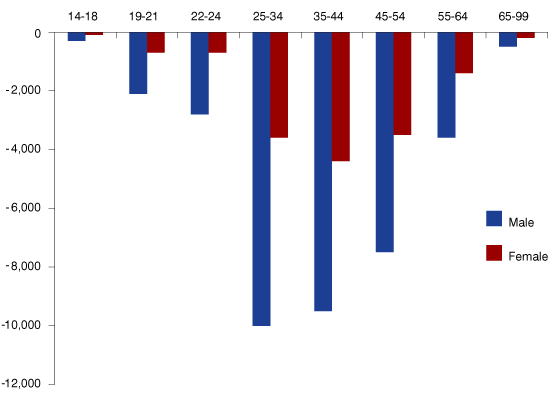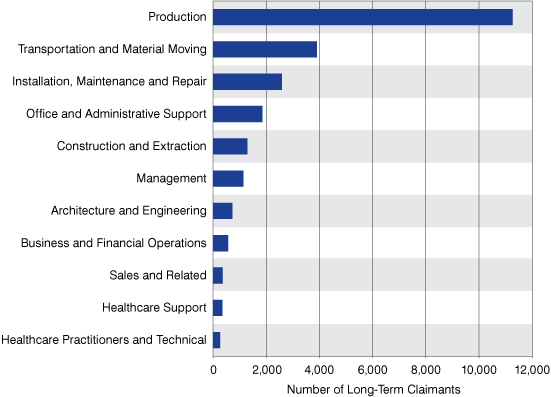Jobs for Displaced Autoworkers
The auto industry has been under tremendous pressure in recent years, in terms of both structural and cyclical change. The tri-state region of Indiana, Michigan and Ohio lost more than 46 percent of its total auto industry employment between June 2006 and June 2009. This article identifies the workers most affected by these changes in the auto industry and previews new tools developed to help these displaced workers transition to new careers. This analysis was conducted by a research consortium of the Indiana, Michigan and Ohio Labor Market Information offices with funding from the U.S. Employment and Training Administration. For more information about the Driving Change project, visit www.drivingworkforcechange.org/.
Job Loss by Occupation
Table 1 presents the top 20 occupations that lost auto sector jobs in Indiana from 2006 to 2009. These data are for the transportation equipment manufacturing sub-sector plus the engine, turbine and power transmission equipment manufacturing industry (this is referred to as TEM-plus). The top two occupations with the greatest job reductions were team assemblers and assemblers and fabricators (all other), accounting for 22 percent of the observed job losses.
Given the ambiguity of the "all other" category, along with some evidence of jobs shifting from one of these categories to the other for the same employer, one may reasonably argue that a single occupation accounted for nearly a quarter of the industry job loss from 2006 to 2009. This consolidated job classification represents more than 13,000 dislocated workers in Indiana and more than 57,000 dislocated workers in the tri-state region of Indiana, Michigan and Ohio.
If O*NET occupational survey demographics for team assemblers also apply to assemblers and fabricators, more than 60 percent have only a high school education—a troubling statistic.
Table 1: Indiana Occupational Employment Loss in the Auto Sector, 2006 to 2009*
| Occupation Code | Title | Loss | Industry Loss Rank | Percent of Auto-Related Loss |
|---|---|---|---|---|
| 51-2092 | Team Assemblers | -8,393 | 1 | 14% |
| 51-2099 | Assemblers and Fabricators, All Other | -4,851 | 2 | 8% |
| 51-4081 | Multiple Machine Tool Setters, Operators, and Tenders, Metal and Plastic | -3,862 | 3 | 7% |
| 51-4121 | Welders, Cutters, Solderers, and Brazers | -2,778 | 4 | 5% |
| 51-9061 | Inspectors, Testers, Sorters, Samplers, and Weighers | -1,936 | 5 | 3% |
| 53-7051 | Industrial Truck and Tractor Operators | -1,803 | 6 | 3% |
| 47-2111 | Electricians | -1,710 | 7 | 3% |
| 51-1011 | First-Line Supervisors/Managers of Production and Operating Workers | -1,636 | 8 | 3% |
| 49-9041 | Industrial Machinery Mechanics | -1,508 | 9 | 3% |
| 51-4199 | Metal Workers and Plastic Workers, All Other | -1,500 | 10 | 3% |
| 51-4032 | Drilling and Boring Machine Tool Setters, Operators, and Tenders, Metal and Plastic | -1,479 | 11 | 3% |
| 51-4034 | Lathe and Turning Machine Tool Setters, Operators, and Tenders, Metal and Plastic | -1,422 | 12 | 2% |
| 51-4031 | Cutting, Punching, and Press Machine Setters, Operators, and Tenders, Metal and Plastic | -1,403 | 13 | 2% |
| 51-4111 | Tool and Die Makers | -1,313 | 14 | 2% |
| 51-4072 | Molding, Coremaking, and Casting Machine Setters, Operators, and Tenders, Metal and Plastic | -1,298 | 15 | 2% |
| 51-9199 | Production Workers, All Other | -1,157 | 16 | 2% |
| 51-9198 | Helpers—Production Workers | -1,061 | 17 | 2% |
| 43-5061 | Production, Planning, and Expediting Clerks | -935 | 18 | 2% |
| 53-7064 | Packers and Packagers, Hand | -931 | 19 | 2% |
| 53-7062 | Laborers and Freight, Stock, and Material Movers, Hand | -908 | 20 | 2% |
* Auto sector defined as TEM-plus.
Note: Shaded rows indicate occupations whose workers have experienced extended unemployment.
Source: Indiana Department of Workforce Development, using QCEW and OES data
The shaded rows in Table 1 indicate that autoworkers in these occupations have experienced long-term unemployment.1 The fact that these are long-term claimants also implies that autoworkers in these occupations are having difficulty finding work in other industries. Either demand for labor in these occupations in other industries is also low—a plausible hypothesis given the massive economic downturn—or there are other structural obstacles that hinder a worker's transition from one industry to another. Increasing inter-industry labor flexibility by concentrating retooling and retraining resources on these 10 occupations could serve to maximize training dollar results.
Job Loss by Age and Sex
Figure 1 illustrates that job losses were not proportional across age and sex in Indiana. In terms of sheer numbers, male workers bore the brunt of the absolute job loss (with a loss of 36,300 jobs between 2006 and 2009, compared to a loss of 14,600 jobs for women). However, women experienced the larger decline on a percentage basis (-39 percent compared to -35 percent).
Figure 1: Indiana Auto Sector Employment Change by Age and Sex, 2006 to 2009*

*Auto sector defined as TEM-plus. Data are based on the second quarter of each year.
Source: Indiana Department of Workforce Development, using Local Employment Dynamics data
The remaining auto sector workforce has become, on average, older and more male, a phenomena partially explained by job tenure.
Autoworkers Experiencing Long-Term Unemployment
Analyzing Indiana's long-term unemployment claimant data for the dislocated TEM-plus sector shows that 67 percent of the dislocated unemployed workforce is male. This is not surprising given that the overall workforce for this industry is roughly 75 percent male. Self-reported occupations for these workers are concentrated in production and transportation and material moving occupations, but span a wide gamut of broad occupational groups (see Figure 2).
Figure 2: Long-Term Claimants by Broad Occupational Category, July 1, 2009 - June 30, 2010

Source: Indiana Department of Workforce Development, using Indiana unemployment claims data
Seventy-five percent of these displaced workers have a high-school education or less (see Figure 3).
Figure 3: Long-Term Claimants by Educational Attainment, July 1, 2009 - June 30, 2010

Source: Indiana Department of Workforce Development, using Indiana unemployment claims data
In addition, more than 47 percent are over the age of 45, as shown in Figure 4. Since many of these workers have not been inside a classroom for decades, retraining for an alternate career may pose a daunting challenge.
Figure 4: Long-Term Claimants by Age Group, July 1, 2009 - June 30, 2010

Source: Indiana Department of Workforce Development, using Indiana unemployment claims data
Finding Work
Auto production rebounded significantly in 2010 and many firms have seen profit margins return. Nonetheless, surveys conducted by the Driving Change research team indicated that management at automaker and supplier firms tend to be concerned about the rebound's permanence and hesitate to expand hiring or production at the rate of previous economic recoveries.
Even though the auto sector is hiring again and has recalled some workers, the rate uptake is not at levels sufficient to rehire all those that lost their jobs. New tools to help these displaced workers find viable career alternatives have been developed by the Driving Change consortium.
- First, a displaced worker can view a list of occupations similar to his or her previous job. These groundbreaking career pathway clusters group occupations into seven clusters based upon the similarities and differences of worker and job characteristics (not industries or functions). Not only are occupations in a given pathway cluster considered similar to one another in terms of their knowledge and skill requirements, but also in the degree to which worker traits such as "highly social" or "attentive to detail" make occupations more or less similar. Job transitions within a given cluster, therefore, would be easier than moving from one cluster to another.
- Next, a worker can find out the relative difficulty or ease in closing the skills gap between a new occupation and his or her previous job. The "trip time" analysis looks at how long it would take to change from one occupation to another based on the amount of preparation (the education, training or apprenticeship time) required for the new job.
- Finally, after a worker generates a set of suitable alternative occupations, he or she can match those occupations with technical, vocational and postsecondary educational programs in the region.
To learn more, all of the Driving Change research results and tools are available at www.drivingworkforcechange.org.
Notes
- Long-term claimants are those who have been unemployed long enough to exhaust the "normal" unemployment insurance benefits and have continued to draw unemployment benefits via the Federal Emergency Unemployment Compensation program. Analysts selected an unduplicated cadre of claimants from Indiana's TEM-plus sector, who received unemployment benefits between July 1, 2009 and June 30, 2010.
Analysis conducted by the
- Research & Analysis Division of the Indiana Department of Workforce Development and
- Timothy Slaper, Director of Economic Analysis, Indiana Business Research Center, Indiana University Kelley School of Business
